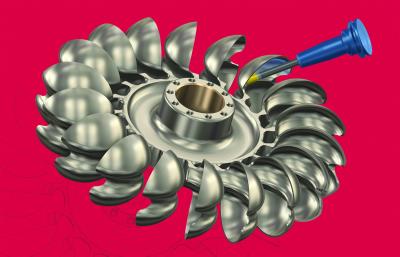
Mastercam Mill offers expanded machining flexibility and an increased emphasis on speed and automation. Multiaxis features, 3D enhancements, and 2D high-speed toolpaths combine with dozens of additional new enhancements in a software package intended to improve shop floor productivity.
Here are some significant highlights and new functionality in Mastercam Mill:
Multiaxis Improvements
Morph, Parallel, Along Curve, and Project Curve are no longer individual toolpaths. Instead, users can now find the same functionality inside the Multiaxis Unified toolpath, which allows for more flexibility in cut pattern when programming multiaxis, all within a new advanced feature set and consolidated, easy-to-use interface. A new Feed Rate Control page consolidates the feed rate control options, making the options easier to find and simplifying your workflow.
3D Enhancements
The Dynamic OptiRough and Area Roughing toolpaths can now be aware of undercut stock conditions, resulting in improvements to the toolpath motion, including less air cutting. Equal Scallop is now a fully stock-aware, semi-finishing toolpath that now identifies material left in corners and will machine with a single pass or with multiple passes to ease into the material. With the new linking parameters in OptiRough toolpaths, you can control and optimize your air cuts which allows for greater efficiency in roughing toolpaths when transitioning between passes or when in air.
2D Enhancements
The Slot Mill toolpath no longer requires two parallel walls when selecting the machining geometry. You are now able to select any closed chain. 2D Contour Profile Ramp now supports the Override feed rate option which allows you to specify a feed rate for the entry or exit move, allowing you to slow down feed rates as you are engaging material. When you drag and drop items in the Toolpath Hole Definition panel, Mastercam now provides visual cues for the drop location. Also, the drag-and-drop icon now indicates whether you are dragging a single item or multiple items.
Additional Improvements in Mastercam Mill that benefit efficiency include:
-
The Tool page and Toolpath parameters tab for milling toolpaths have been redesigned to provide a better, user-friendly layout.
-
Automatically Detecting and Including Stock for Z depths is now included for 3D high-speed toolpaths.
-
New Feed Rate Control page for Multiaxis toolpaths which consolidates the feed rate control options, making them easier to find and simplifying your workflow.
Contact Details
Related Glossary Terms
- feed
feed
Rate of change of position of the tool as a whole, relative to the workpiece while cutting.
- gang cutting ( milling)
gang cutting ( milling)
Machining with several cutters mounted on a single arbor, generally for simultaneous cutting.
- milling
milling
Machining operation in which metal or other material is removed by applying power to a rotating cutter. In vertical milling, the cutting tool is mounted vertically on the spindle. In horizontal milling, the cutting tool is mounted horizontally, either directly on the spindle or on an arbor. Horizontal milling is further broken down into conventional milling, where the cutter rotates opposite the direction of feed, or “up” into the workpiece; and climb milling, where the cutter rotates in the direction of feed, or “down” into the workpiece. Milling operations include plane or surface milling, endmilling, facemilling, angle milling, form milling and profiling.
- milling machine ( mill)
milling machine ( mill)
Runs endmills and arbor-mounted milling cutters. Features include a head with a spindle that drives the cutters; a column, knee and table that provide motion in the three Cartesian axes; and a base that supports the components and houses the cutting-fluid pump and reservoir. The work is mounted on the table and fed into the rotating cutter or endmill to accomplish the milling steps; vertical milling machines also feed endmills into the work by means of a spindle-mounted quill. Models range from small manual machines to big bed-type and duplex mills. All take one of three basic forms: vertical, horizontal or convertible horizontal/vertical. Vertical machines may be knee-type (the table is mounted on a knee that can be elevated) or bed-type (the table is securely supported and only moves horizontally). In general, horizontal machines are bigger and more powerful, while vertical machines are lighter but more versatile and easier to set up and operate.
- parallel
parallel
Strip or block of precision-ground stock used to elevate a workpiece, while keeping it parallel to the worktable, to prevent cutter/table contact.
- toolpath( cutter path)
toolpath( cutter path)
2-D or 3-D path generated by program code or a CAM system and followed by tool when machining a part.
- undercut
undercut
In numerical-control applications, a cut shorter than the programmed cut resulting after a command change in direction. Also a condition in generated gear teeth when any part of the fillet curve lies inside of a line drawn tangent to the working profile at its point of juncture with the fillet. Undercut may be deliberately introduced to facilitate finishing operations, as in preshaving.
